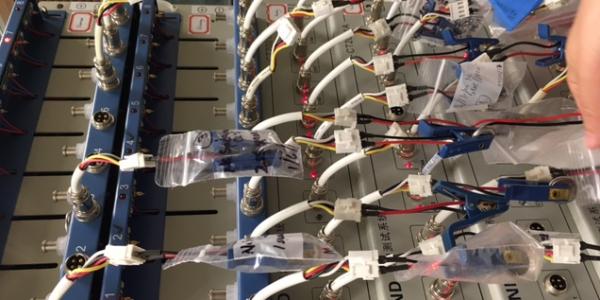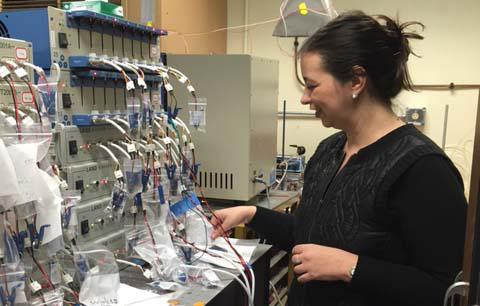A Clear Winner in Charge To Build Better Batteries
Researchers at the University of Texas at Austin have developed a solid-state battery that they believe solves many of the problems inherent in today’s lithium-ion cells. It could lead to safer, faster-charging batteries for handheld communication devices and electric cars, including unmanned vehicles. And it has at least three times as much energy density for longer life—or for an electric car, more miles between charges.
As the world becomes increasingly connected and mobile, everyone wants more juice from batteries. Although the lithium-ion battery has been essential to the growth of consumer handheld devices and the operation of more reliable government mobile communication systems, it is not without drawbacks. While packing plenty of power, lithium-ion batteries can be temperamental and prone to catastrophic failures. For military and commercial users in the field or in remote environments, a more dependable, rugged power supply is needed.
Researchers developed the new battery in part to overcome the problems of the lithium-ion variety, explains John Goodenough, a professor at the University of Texas (UT) at Austin’s Cockrell School of Engineering. One of the inventors of the lithium-ion battery in the early 1980s, the 94-year-old Goodenough never was satisfied with it because of its flammability. “We understood the problems with the lithium-ion battery originated with the fact that you have a flammable liquid organic electrolyte,” he explains. “We knew we needed a solid electrolyte and the ability to plate a metallic lithium anode.”
Lithium-ion batteries use liquid electrolytes to move lithium ions between the anode, or negative side of the battery, and the positive cathode to create an electric current and discharge the battery. Charging a battery too quickly can cause thin metal threads, or dendrites, to form in the cell and cross through the liquid electrolytes. This can cause a short circuit, with the potential for an explosion and a fire as the battery fails catastrophically.
Goodenough, who holds a doctorate in physics from the University of Chicago, was researching ways to circumvent these design flaws when he came across the work of Maria Helena Braga, a professor at Portugal’s University of Porto. She was experimenting with solid glass electrolytes doped with lithium or sodium. The two scientists began collaborating, and Goodenough invited Braga to Austin, where she is now a visiting research fellow and a co-developer of the glass battery.
Braga’s work with solid-state glass electrolytes helped create a battery with greater energy storage than current batteries. High energy density translates to longer operating times for radios and handheld devices and increased range for electric vehicles. In addition, Goodenough maintains that the solid-state glass battery is very durable because the glass is made in a slurry that is inserted into a cellulose membrane. When the slurry dries, it forms a glass layer on the membrane, making it tough but flexible. Perhaps most important, the new battery will not combust because there is no liquid electrolyte to form dendrites.
Another key part of the battery is an alkali-metal anode that can be plated with lithium, sodium or potassium, which is not possible with conventional batteries, Goodenough says. The glass electrolytes allowed UT Austin engineers to plate and strip alkali metals on both the anode and cathode sides while retaining sufficient power levels. This structure increases the cathode’s energy density and provides a long cycle life, both improvements over lithium-ion batteries. Their poor charge cycle stems from ventilation layers built into the battery on the anode side for safety reasons, to prevent or mitigate dendrite formation.
The glass battery can be recharged more than 2,000 times with no loss of performance, Goodenough points out. One of its chief advantages is low internal resistance, which means the cell delivers a high current on demand. Another is recharge speed. The solid-state battery can be recharged in minutes rather than hours because the lithium- or sodium-doped electrolytes have a far greater ability to store energy, the university reports.
The battery also can operate in extreme temperatures. It functions at minus 20 degrees Celsius without special heating or insulation considerations and is the first all-solid-state battery capable of performing below 60 degrees Celsius, according to the university.
Additionally, the battery’s glass electrolytes could make low-cost mass production possible because the cell can be manufactured from more commonly available materials than today’s product. “The glass electrolytes allow for the substitution of low-cost sodium for lithium. Sodium is extracted from seawater that is widely available,” Braga said in a statement.
Also, to lower development costs, the team eliminated the separator—usually a polymer placed between the battery’s anode and cathode—because the glass electrolyte acts as a separator.
Still, development challenges remain. The UT Austin team has not yet optimized the battery’s cathode side for power output and capacity. Goodenough notes that university researchers are working on ways to achieve this. One potential approach is plating from the anode to the cathode to allow current to flow. Plating one end of the cathode currently limits the battery to about 3 volts as opposed to the power output of a traditional battery. The team has been able to push this to nearly 5 volts without oxidation. “I think that the fundamental principles have been solved. [But] as far as the cathode is concerned, there’s still work to be done to optimize capacity,” Goodenough says.
The Texas researchers demonstrated the ability to make a high-voltage cathode using a compound of lithium, nickel and manganese. This compound has not been used in batteries because it can produce such a high voltage that it would oxidize the liquid electrolyte and lead to a short circuit, Goodenough explains. “We’ve been able to put something between the glass and the high-voltage cathode that allows us to go to 5 volts without there being a problem of oxidizing something. But it uses a different concept in order to be able to work,” he says.
Goodenough cautions that the glass battery is only a demonstration model. Manufacturers have expressed interest in the battery and are readying it for mass production, but a working product will not be available for several years.
While the UT Austin researchers worked with cells roughly the size of a nickel, commercial manufacturers hope to go bigger. The goal is to scale up to larger, more powerful cells. “In principle, we’ve demonstrated that we can do traditional cathodes with high voltage, but we can’t go above 5 volts,” Goodenough says. To do so would take even more energy density, he adds.
Ultimately, a commercially viable battery will have to be easy and inexpensive to manufacture and offer much greater power and charging speed compared with lithium-ion batteries. “It has to compete with fossil fuels if you’re going to drive cars with it,” Goodenough says.






Comment
The invention of the glass
The invention of the glass battery is going to revolutionize a greater demand for clean and cheap energy. I want to buy a Glass battery as soon as they are on the market.
great article
great article
There is way too much wobble
There is way too much wobble in the descriptions of this thing, # recharges, solid/liquid, proton motion/no motion. A simple picture of the layers and structure plus a quick demo of the working model would help enormously. Or, it could be, that like EESTOR, they just chose the wrong city to do this and blew up the prototype... Explanation, I'm incredibly lazy and too far away from Austin or from a good university library to find their research pubs. Would some young person (not 94 or my 72) please do the diligence and deliver a cogent explanation with the guts of their publications so that old guys like me, 72, can see what's really going on :)
Comments